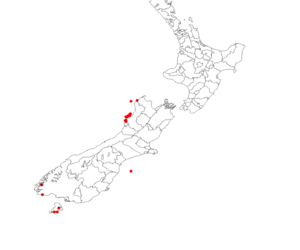Actinotus novae-zelandiae facts for kids
Quick facts for kids Actinotus novae-zelandiae |
|
|---|---|
| Scientific classification | |
| Genus: |
Actinotus
|
| Species: |
novae-zelandiae
|
 |
|
| Occurrence data from AVH | |
| Synonyms | |
|
Hemiphues novae-zelandiae Petrie |
|
Actinotus novae-zelandiae is a type of plant that belongs to the Apiaceae family. This plant is native to the South Island of New Zealand.
About This Plant
A. novae-zelandiae grows in a special way, forming a flat mat or a soft cushion on the ground. It has fewer anthers (the part of a flower that makes pollen) than most other plants in its group, with only two anthers.
This plant looks a lot like another plant called A. suffocatus. However, there are a few differences. The leaves of A. novae-zelandiae do not have a clear stalk (petiole). Also, the tip of its leaves is a bit hard, like cartilage. It usually has 5 to 6 leaf-like parts called bracts around its flower heads. These bracts are wide and shaped like a triangle. In contrast, A. suffocelflower|A. suffocatus has more bracts, usually 8 to 13, and they are narrower.
Where It Lives
You can find Actinotus novae-zelandiae in the western and southern parts of New Zealand's South Island. It also grows on Stewart Island. This plant likes to live in both low-lying areas and high mountain regions. It prefers places that are wet or boggy.
How It Was Named
This plant was first described in 1880 by a scientist named Donald Petrie. He first gave it the name Hemiphues novae-zelandiae. Then, in 1881, he described it again and changed its name to Actinotus novae-zelandiae, which is the name we use today.
Its Conservation Status
Scientists in New Zealand check on the health of different plant and animal species. In 2009, 2012, and again in 2018, Actinotus novae-zelandiae was officially listed as "Not Threatened." This means that there are enough of these plants, and they are not currently at risk of disappearing. However, in 2018, they also noted that it is "Data Poor" (DP). This means scientists don't have all the information they need about the plant, so more research might be helpful.

